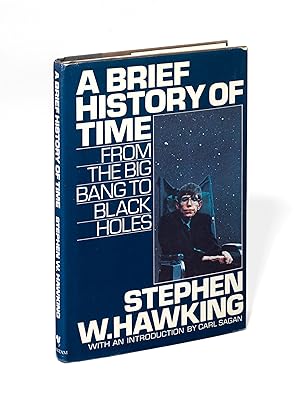Hawking Stephen Theoretical Physicist (3 results)
FeedbackSearch filters
Product Type
- All Product Types
- Books (No further results match this refinement)
- Magazines & Periodicals (No further results match this refinement)
- Comics (No further results match this refinement)
- Sheet Music (No further results match this refinement)
- Art, Prints & Posters (No further results match this refinement)
- Photographs (No further results match this refinement)
- Maps (No further results match this refinement)
- Manuscripts & Paper Collectibles (3)
Condition
- All Conditions
- New (No further results match this refinement)
- Used (3)
Binding
Collectible Attributes
Language (2)
Price
- Any Price
- Under £ 20 (No further results match this refinement)
- £ 20 to £ 35 (No further results match this refinement)
- Over £ 35
Free Shipping
- Free Shipping to United Kingdom (No further results match this refinement)
Seller Location
Seller Rating
-
Typed letter signed ("Stephen").
Published by Cambridge, 10. XI. 1970., 1970
Seller: Antiquariat INLIBRIS Gilhofer Nfg. GmbH, Vienna, A, Austria
Manuscript / Paper Collectible
£ 31,174.44
Convert currency£ 25.94 shipping from Austria to United KingdomQuantity: 1 available
Add to basket4to. (197:244 mm). 1 page. On headed "air letter" paper. To Charles W. Misner: one of Hawking's students, Gary Gibbons, is to attend the meeting of the American Physical Society in New Orleans from 23-25 November, "where he will report on the British work on the design and construction of gravitational wave detectors. We think that, without the use of liquid helium, we can improve the sensitivity by a factor of 100. The first of these detectors should be operating before the end of the year, and the second one at Reading should follow soon after". Hawking hopes that Gary might stay on after the New Orleans meeting to attend the relativistic astrophysics conference in Austin, with a visit to the University of Maryland in between, and asks for Misner's help in organising this visit: [Joseph] Weber will be too busy to show Gibbons around, but Hawking notes that Gary should really see Misner and [Dieter] Brill: "he is primarily a theoretician and is interested in the problem of how much gravitational radiation would be emitted by a collapsing object". Hawking also announces the birth of a little girl, "Catherine Lucy, though we will probably call her Lucy", born a little plumper than Robert, and very well behaved. - In 2016, over 45 years after Stephen Hawking's hopeful mention in the present letter of the gravitational wave detectors being built in England - and one hundred years after Albert Einstein first predicted the existence of gravitational waves - scientists would finally have proof of these elusive ripples in space-time: the unmistakeable "ringing" as two black holes collides was heard at the Advanced Laser Interferometer Gravitational-Wave Observatory (LIGO) on 11 February 2016. When asked for comment, Hawking said that the discovery would "revolutionise" astronomy, noting also that it had proved his calculations of 1970 to be correct: "The observed properties of this system are consistent with predictions about black holes that I made in 1970 here in Cambridge". Hawking and his student Gary Gibbons would go on to collaborate in their research, lending their names to the "Gibbons-Hawking effect", "Gibbons-Hawking space", and the "Gibbons-Hawking ansatz". - Provenance: Charles W. Misner.
-
A Brief History of Time. From the Big Bang to Black Holes.
Published by New York, Bantam Books, 1988., 1988
Seller: Antiquariat INLIBRIS Gilhofer Nfg. GmbH, Vienna, A, Austria
Manuscript / Paper Collectible First Edition Signed
£ 16,032.57
Convert currency£ 25.94 shipping from Austria to United KingdomQuantity: 1 available
Add to basket8vo (230 x 153mm). Text illustrations. Publisher's black quarter cloth, blue pictorial dustjacket. First American edition with authorial thumbprint of Hawking's bestselling science classic. A fine copy, 'signed' with an authorial thumbprint on front free endpaper. - Provenance: Judy Fella (Hawking's first secretary, and later PA and nursing coordinator: Fella worked with Hawking on the first draft of "A Brief History of Time").
-
Stephen Hawking (1942-2018) - Exceedingly rare witnessed signed card - 2012
Publication Date: 2012
Language: French
Seller: PhP Autographs, Hastière, Belgium
Manuscript / Paper Collectible Signed
£ 4,364.41
Convert currency£ 15.57 shipping from Belgium to United KingdomQuantity: 1 available
Add to basketPas de couverture. Condition: Bon. - Exceedingly rare piece with superior provenance - Card signed by Stephen Hawking using his right thumbprint in September 2012. The card is autographed and certified by Stephen Hawking's personal assistant, Judith Croasdell and the envelope. Size : 20x12.5 cm. Condition : please see scans. Provenance : Gérard Leman collection. Certificate of Authenticity and lifetime guarantee. Signé par l'auteur.




